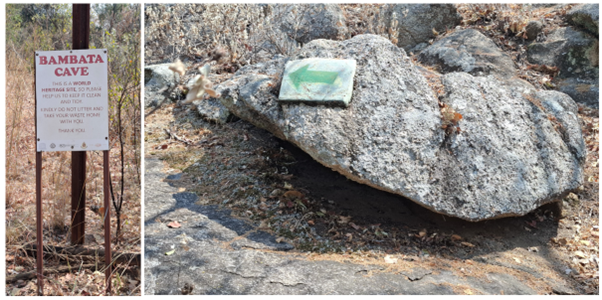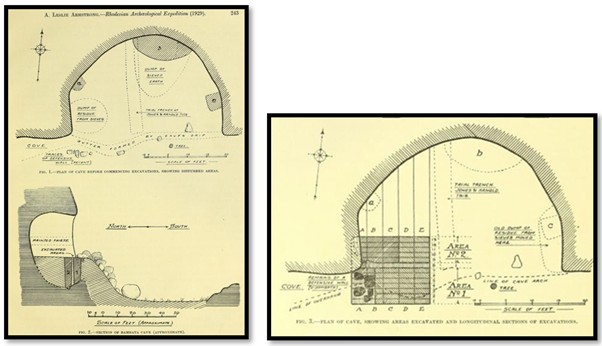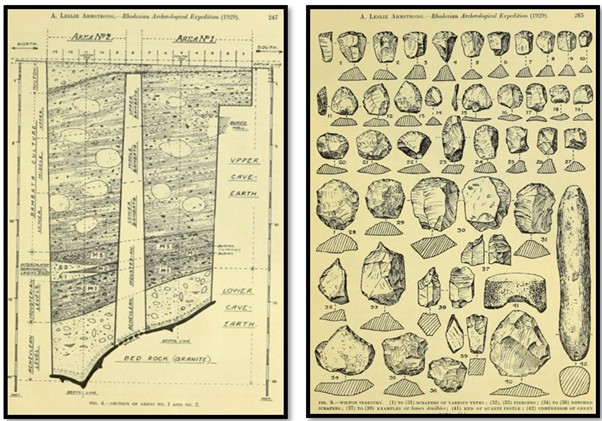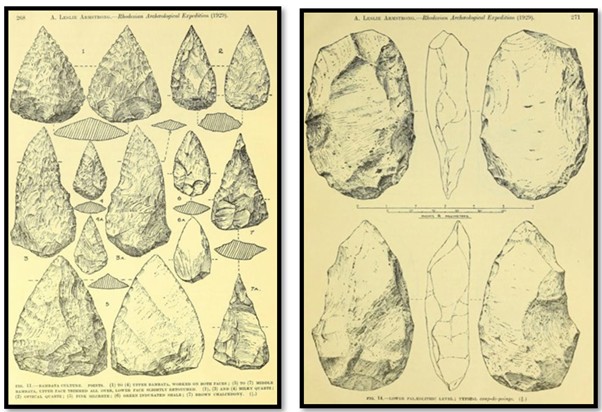Bambata Cave - rock art paintings
Probably the most excavated cave in Zimbabwe and one of the earliest inhabited sites of human occupation. The excavations have revealed a deeply stratified sequence of cultures. As a result Bambata Cave became the type-site of the Middle Stone-Age nam ed the Rhodesian Still Bay Industry that was characterised by the production of leaf-shaped, bifacially-shaped stone tools, known as Still Bay points.
The cave excavations resulted in its unique style of pottery being named as 'Bambata Ware.' Pottery characterised by thinly made, stamped, and patterned (like herringbone) that dated to the 1st millennium A.D.
A very representative selection of the typical San rock art of Matabeleland with antelope including kudu and impala, elephants, felines, giraffes, rhino, tsessebe and human figures, some in trance-related poses, plus ovoid shapes. Some of the humans suggest ritualistic or trance-related imagery, with figures in familiar trancer poses and dynamic compositions. As Peter Garlake writes "They are not particuarly vivid, neither are the subjects particuarly striking or unusual. Many are, however, of considerable quality and cover the full range of the Matobo art."
The cave sits below the summit of Bambata Hill and has relatively easy access in a wonderful landscape of enormous dwalas of the Matobo Hills.
Access directly from the Kezi / Antelope road is no longer possible with the road overgrown and the gate locked.
Access is now via the main Whovi Wild Area Game Park and distances are from the main road. 0.4 KM turn right, 0.61 KM turn right, 1.92 KM continue straight on, 2.6 KM continue straight on, 3.22 KM cross the stream, 3.29 KM keep left, 3.61 KM reach Chitamba Dam, 4.8 KM cross the stream, 5.51 KM continue straight on, 6.0 KM turn right, 7.82 KM turn right, 11.88 KM continue straight on, 12.5 KM turn right - signposted Bambata, 13.2 KM reach Bambata Cave car park.
From here follow the footpath from the car park up alongside a small streamand and then up the gradual slope of the dwalas. The walk is well sign-posted with green arrows. As the crow flies the cave is less than a kilometre from the car park.
Bambata Cave 20° 29´ 59.39°S 28° 24´ 46.24° E
Bambata Cave car park 20° 30´ 23.76°S 28° 24´ 41.68° E

Description of the archaeological excavations at Bambata Cave
Bambata cave was first explored in 1917 by Neville Jones who returned to excavate the following year with George Arnold. He made subsequent excavations in 1938 and1939. They revealed a great variety of tools and implements beneath the dust, soil and ash that had accumulated over thousands of years of human occupation. An area of 4.9 metres long, 1.8 metres wide and 1.2 metres deep was excavated at the back of the cave and two smaller holes on the east and west sides. Wilton-type scrapers and crescents in jasper and white quartz with pottery pieces polished brown to black were found and recorded.
In 1929 a more extensive examination was made; a camp named "Paradise Camp" was established a few metres outside the cave. Many of the artefacts unearthed during this excavation can still be seen lying around on the ground.

1929 Excavation sketches by A. Leslie Armstrong
The results of the 1929 excavation were written up by the archaeologist A. Leslie Armstrong who summarized his report Rhodesian Archaeological Expedition (1929): Excavations in Bambata Cave and Researches on Prehistoric Sites in Southern Rhodesia as follows:
“Two sections were systematically excavated to the bed-rock of the cave, a maximum depth of 20 feet 3 inches, and yielded a complete sequence of deposits varying from Lower Paleolithic (South African Acheulean), to a Microlithic culture, believed to be ancestral to the Wilton culture of the Cape. The succession of cultures was found to be in close agreement with the European sequence. In addition to the work of excavation, the whole of the wall-paintings were carefully traced.”
The artefacts found in Bambata cave are categorised into different cultures based on the layers discovered in the two excavations named Area 1 and Area 2. Wikipedia's description follows of the stratified cultural layers:
Area 1
Grey ash layer
Grey ash layer is characterized by the artefacts of the Wilton Industry including microlith scrapers, crescent and triangularly-shaped tools, shell beads and bone equipment and small burins (tools with a chisel point) Pencils and small balls of hematite and red ochre showed that the inhabitants used them for painting.
Upper cave-earth
Shell beads and microliths, as well as Wilton tools were found in this layer. The artefacts became more elementary in character and technique as it is approached the end of this layer. Raw coloring materials, such as yellow ochre, pencils, pieces of red and brown hematites and ochres, were found.
10-feet 6-inch level
The next layer is characterised by the Mousterian Industry with tools made of igneous rock, milky quartz and chalcedony, as well as choppers and hand-axes were found in this layer.
Lower Cave-earth
This layer is full of fragile granites and pieces of milky quartz. Most of them were used as scrapers or knives. Oval tools made of semi-transparent quartz and early forms of cleavers were also found.

Profile of the 1929 Excavation trenches and illustration of various types of Wilton Late-Stone Age tools excavated
Area 2
The Wilton level, Upper cave-earth, 12-feet level and 16-feet 6-inch levels were identified in Area 1 in this area.
- Wilton level is more precise in Area 2 comparing with Area 1. The layer consisted of grey ash with a total thickness of 18 inches. Spalls and fragments of desquamated granite together with artefacts formed a pebble bed representing the heavy leftover from the surface eroded by wind. Camp fires were built by Wilton people upon these peddle-beds, and as a result, the older floor extended on the back side of the cave and became deeper.
- Upper Cave-earth. Artefacts found here were similar to the ones found in Upper Cave-earth layer of Area 1.
- 12-feet level. Mousterian industry. In the upper layer, the remnants were the same type of tools found in the Mousterian level of Area 1. In lower areas, brown sandy insoluble materials containing quartz and feldspar crystals, as well as fragments of white tufaceous. Wood ash or charcoal was not noticed here.
- 16-feet 6-inch level. This level is characterized by Acheulean types of tools. The two-faced stone hand axes were revealed here at 16 - 17.5 feet on the south side. Saucer shaped pockets of black loamy earth and fragments of charcoal were found in this layer.

A further excavation in 1980 traced the development of of Late Stone-Age tool technology back to 200 B.C. The upper deposits contained Bambata pottery and sheep bones and teeth suggesting that some Stone-Age communities became pastoralists as well as potters.
Origin of the name Bambata
The original isiNdebele name was 'ugubambata' meaning to stroke or caress with the hands. It is said that when the amaNdebele King Mzilikazi climbed down the hill he had some difficulty and was forced to climb down on all fours so that his hands caressed the hill.
Physical characteristics of Bambata Cave
Bambata cave measures 11.4 metres across at the entrance and is 8.4 metres deep. The cave is a great semi-spherical hole in the granite dwala filled with thousands of years of ash, sand and dust deposits that have gradsually raised the level of the floor to over 6.5 metres. Buried deep within these deposits are the stone tools and implements of those Late Stone-Age artists who painted on the walls of this cave. Like Silozwane and Nswatugi caves these large smooth-walled caves were formed by negative spheroidal weathering with erosion of the internal joints within the granite mass of the great smooth 'whale backs' or amadwalas; the opposite of the erosion through exfoliation on the dwalas themselves that is called positive sphereoidal weathering, or simply 'onion skin peeling.'
The Paintings
Top left of the cave has the faded remains of three large elephant. Under the central elephant is a feline, possibly a cheetah. Next to it are several tapered triangles with heads at one end and three sitting humans - these may be humans sleeping under karosses. To their left are a group of five large antelope, including at least one eland. Under them are a line of five faded Roan antelope lying down, with one, unusually, shown from the front and not in profile. Long lines of hunters are below the Roan antelope. To the left of this group is a line of nine hunters, some with rattles or animal ears.
On the far left of the cave is a small giraffe with seated human family groups alongside. A faded ochre feline is beneath two running hunters with the faint bremains of a large rhino. To there right is another faded yellow ochre feline with the outline of a zebra underneath and the head and neck of a large giraffe with a elongated, recumbent figure, hand to head, above its back. Then three faint humans, to their right are three small dark tsessebe and a figure possibly in trance.
On the right of the cave is a large ovoid design with nine elements with ochre cores and grey caps and bases. The cores have patterns of dark dots and lines. Below a figure lies recumbent with one hand on his head and one leg bent back. Below is a faded elephant and beneath are two seated figures. Superimposed on them a figure with a tail, another with a line coming from his hand and a third with long arms raised.
To their right are a line of twenty-five elongated humans; above them are seven bushbuck. They are superimposed on an outline, possibly an ovoid, Below the hunters three women have bags at their waists and long sticks, plus other indistinct figures.
On the right side of the frieze are a pattern of parallel lines with one human figure within them and four other humans attached. The lower lines become a small human obese torso with arms raised. A line from its hand leads to a similar figure beside it holding a crescent. a second line leads to a pair of squatting figures. A third figure has raised arms. The design is broken by a pattern based on a pair of striped lozenges joined together that garlake states is a recurrent matobo feature.
References
C.K. Cooke. A Guide to the Rock Art of Rhodesia. National Museums and Monuments of Rhodesia 1974.
E. Goodall, C.K. Cooke, J. Desmond Clark. Editor R. Summers. Prehistoric Rock Art of the Federation of Rhodesia and Nyasaland. National Publications Trust. 1959
P. Garlake. The Painted Caves: An Introduction to the Prehistoric Art of Zimbabwe. Modus Publications (Pvt) Ltd, 1987
R.J. Fothergill. The Monuments of Southern Rhodesia. The Commission for the preservation of natural and Historical Monuments and Relics. 1953
A. Leslie Armstrong. Rhodesian Archaeological Expedition (1929): Excavations in Bambata Cave ans Researches on Prehistoric Sites in Southern Rhodesia
Wikipedia
